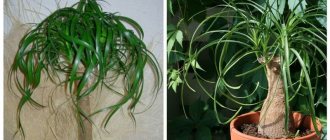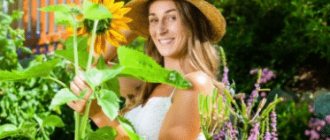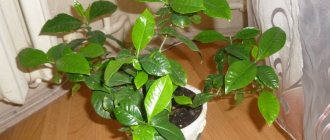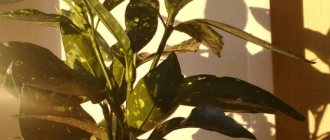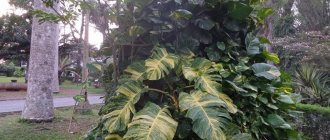Vriesia was isolated from the Tillandsia genus, which in turn has more than 250 species. Another name that is also often used by gardeners is frisia.
In the wild, the flower grows in the tropics and subtropics of America. Flowers live on the bark of trees and in gorges. Wild representatives feel great even on the highest rocks.
Vriesia in the wild
What does it look like
The leaf rosette of Vriesea Splenriet looks like a funnel consisting of long, hard leaves. Leaf blades may be green or striped. The peduncle grows from the very center of the funnel and is decorated with a spike-shaped inflorescence. The bracts fit tightly together and are colored in a wide variety of shades. Depending on the varietal variety, the stem can be single or branched.
Vriesia flower
Vriesia: growing and care at home
For the vriesia flower, care at home consists of a large number of necessary measures. The decorative appearance of the plant and unusual flowering are possible if the rules of cultivation and care are followed.
Temperature
Vriesia - home care, how Vriesia blooms
Vriesia Splenriet is very particular about the temperature regime. The plant is thermophilic. A climate with a constant temperature of at least +18 degrees suits it best.
Important! The plant will not survive in open ground; it does not tolerate even the slightest temperature changes.
Lighting
In winter, it is best to place the plant in the most illuminated place. In summer, the pot should be moved to partial shade to prevent burns.
Watering
The culture loves moisture, prefers settled warm water. In the cold season, the Vriesia flower is watered only once a week, in the summer - 2 times. The plant loves it when watering is done not only into the ground, but also directly into the leaf funnels. Full sprinkling is best done in the summer.
Spraying
It is important to keep the plant in constantly moist conditions. This is achieved by spraying. It is advisable to do it several times a day. It is necessary to irrigate the entire flower and soil.
Humidity
The plant is native to the tropics. It is very important to maintain the required level of soil moisture for the flower at home. A good way is to place the plant on a special tray filled with drainage and water.
Priming
The substrate for the plant should be as light and loose as possible. To prepare you need to mix:
- garden soil - 2 parts;
- turf soil – 1 part;
- sifted sand - 1 part;
- pine bark - 1 part.
Important! Pine bark requires mandatory processing before use. It can be baked in the oven or covered with steam. This will disinfect the bark and rid it of harmful insects.
Adding sphagnum or charcoal to the mixture will promptly rid the plant of excess moisture. If you don’t want to prepare the soil yourself, you can purchase it at a specialized store.
Feeding
Caring for vriesia involves applying liquid fertilizers throughout the spring and autumn. Feeding is carried out once every 14 days. In this species, nutrients are applied directly to the outlet, since the root system does not affect the proper development of the flower.
Short description
Botanists classify Vriesia as a member of the bromeliad family, and this unusual perennial came to us from South America, where it can most often be found in forests and trees. Today there are about 270 species of this plant, which are very popular among flower growers around the world due to their bright, spectacular color and original appearance, so they are grown both in open ground and indoors. Moreover, the flowers themselves are of little interest, since they fade quickly; it’s all about the bracts, which can last for several months and give the vriesia even more decorative and exotic.
The flowering period largely depends on when the vriesia was planted, but it typically blooms in the summer. This plant is epiphytic and its roots rather serve as an anchoring function to the soil, since it does not serve as a source of nutrition for the flower. The height of Vriesia usually does not exceed 80 cm. Some species are distinguished by their scaly or multi-colored striped leaf covering.
The leaves themselves are voluminous, powerful, funnel-shaped, their length can vary from 20 to 70 cm, and the leaf blade has a pointed end. The peduncle, reaching a height of more than a meter, forms an inflorescence with bracts of various colors - most often green, orange, scarlet and yellow, which are able to retain their visual attractiveness for a very long time. It is curious that the flower was nicknamed “fiery sword” for its unusual shape of inflorescences . Vriesia produces fruits in the form of a miniature box filled with wrinkled seeds.
Did you know? The name of the flower was given in 1844, in honor of the famous Dutch florist Willem de Vries.
Immediately after flowering ends, most plant species die off, which is accompanied by drying out of the peduncle and leaves. But this is an absolutely normal process, because after some time new shoots begin to appear from the ground. The flowering of Vriesia is a very fascinating and pleasing sight to the eye, but this plant is very capricious, so before you get a flower at home, think about whether you can provide all the necessary conditions for it and maintain it properly all year round.
Transfer
Dipladenia (Mandevilla) - growing and care at home
Transplanting an indoor vriesea flower should be carried out only in the most extreme cases. The plant reacts painfully to this process. Transplantation is possible only if the pot has become small. Even with the slightest damage to the roots, the flower will take a long time to recover, and may even die.
Attention! It is forbidden to deepen the flower rosette - this may cause rotting of the base.
Is it possible to keep it at home - signs and superstitions
Flower growers believe that vriesia can attract success and good luck to the house, as well as give its residents health and longevity. In addition, culture helps to cope with depression and motivates its owner to conquer new heights in all areas of life.
It is better to grow a flower for those who are not confident in themselves and believe that their life needs changes. In addition to its magical properties, the plant has the properties of a natural filter. It absorbs harmful impurities from the air, purifies it and makes it safe for the inhabitants of the house, especially for allergy sufferers.
How does it reproduce
There are two options for propagating the Vriesea Splenriet flower: seeds and suckers.
Vriesia keeled from seeds
This is a complex and extremely thankless method of reproduction. To collect seeds from a flower, you must wait until the peduncle has fully matured. Sowing is carried out in a mixture of river sand and sphagnum. To improve germination, seed material is pre-treated with potassium permanganate and dried.
Flower seed shoots
Watering is best done using a spray bottle. The container with plantings is covered with glass and constantly ventilated. The first shoots will appear only in a month. The young plant picks up after the first true leaves appear. The substrate for it should consist of peat, leaf and turf soil. After six months, the vriesia is transplanted into a larger container. Flowering of an ornamental plant grown from seeds will begin no earlier than after 5 years.
Vegetative propagation
Replanting Vriesia after flowering is done after it has completely faded. Young shoots form in place of the flower. When the “kids” grow enough, they need to be separated from the “parent” and planted in another pot.
Plant propagation by children
The substrate is prepared from 3 parts of leaf soil, 1 part of sifted sand, 1 part of pine bark. During rooting, the young flower of Vriesia Splenriet is covered with a film or bag. The rooting process occurs within approximately 30 days. Only after this can the plant be transplanted to a permanent place of residence.
On a note! Flowering will begin only 4 years after transplantation.
Bromeliad tree
Bromeliad tree surprises everyone
Everyone is used to growing vriesea in pots. But because of the flower’s ability to grow on snags and tree bark, a great opportunity opens up for you: to create a miracle called a bromeliad tree with your own hands. To do this you need:
- Find a suitable medium - a snag or branch that you like.
- Place it firmly in the container. The main thing is to strengthen the structure very firmly, using stones, plaster or polyurethane foam.
- Wrap the roots of the vriesea with sphagnum moss and strengthen it with a thin fishing line.
- Place plants throughout the carrier and secure with fishing line or wire.
- Caring for the tree will include spraying moss and watering the leaf rosette. Once every 10 days, the plants will need to be dipped in water, first disconnecting them from the carrier, and then returned to their place.
Possible problems
If watering rules are not followed, the plant may become infected with fungal diseases. Most often it is gray rot or fusarium. For urgent treatment, it is necessary to adjust the watering regime - reduce it. Then the freesia needs to be treated with a fungicide.
Insufficient humidity in the room will immediately affect the plant. The ends of the leaves will immediately begin to dry out. Treatment is to increase the humidity level in the room.
Why doesn't Vriesia bloom?
The main reason for the lack of flowers is cold air. Flowering of Vriesia can be achieved artificially:
- The pot is covered with any transparent vessel.
- Fresh fruits are laid out near the plant.
Additional Information. The fruit contains ethylene, a substance that causes the flowering process.
Pests
There are a number of pests that can damage vriesea: spider mites, thrips, scale insects. These insects cause yellowing of the leaf blade and rotting of the roots. To protect the plant, it is necessary to urgently treat it with a soap solution and then spray it with fungicides. The scale insects that often live on the flower can only be removed by hand.
Important! When the first signs of a pest invasion appear, the plant must be isolated from other indoor flowers.
Common varieties
There are more than 250 species of Vriesia in the wild. There are significantly fewer indoor subspecies and they come in two types: with plain and with striped leaf plates.
With plain leaves
Many varieties of Vriesia are represented by monochromatic foliage in different shades. The inflorescences can also have different colors.
Royal
This is the largest representative of Vriesia Fenestralis. The leaves can reach 50 cm, and the peduncle – 2 meters. The inflorescences of this species resemble a panicle. In the early stages, the flowers are white, and after full maturity they are yellow. The royal variety has a very strong aroma.
Royal variety
Mix
This is the most interesting species, which has won a lot of fans thanks to its unusual appearance and variety of color palette of inflorescences. Its foliage is bright green, its flowers are oddly shaped with highly branched inflorescences in the middle. The color can be yellow, orange, red or cherry.
Vriesia Mix
With striped leaves
Striped leaves can have a longitudinal or transverse pattern. The flowers of these varieties are red, yellow, and orange.
Types of Vriesia with photos
Vriesea fenestralis
Leaves in a rosette are up to 40 cm long and 6-6.5 cm wide, light green, with a large number of dark green veins, transverse and longitudinal stripes, smooth above, finely scaly below, brown-red at the top. Inflorescence up to 50 cm tall and 9 cm wide. The flowers are light yellow; bracts with green and dark brown spots. Brazil. Decorative look. Cultivated in warm greenhouses.
Vriesea gigantea
The leaves are in a rosette (rising goblet-shaped above the soil surface), short-belt-shaped, strong, dark green, with light yellow spots above, reddish-lilac below. The inflorescence is a weakly branched panicle, up to 2 m long (panicle 1-1.2 m long). The petals are wide, bell-shaped, yellow. Grows in tropical rainforests in Brazil. Decorative appearance. Cultivated in warm greenhouses.
Vriesea imperialis
The leaves are in a rosette, large, up to 1.5 m long, wide, 10-12 cm wide, green, curled at the apex. The peduncle is very strong, densely covered with leaves. The inflorescence is a branched panicle; all branches in dense flowers (35-40 in number). The flowers are large, 15-17 cm long, yellowish-white; bracts red or green. Found in tropical rain forests in Brazil.
Vriesea hieroglyphica
South America. Perennial up to 1 m tall. Short, hollow stem. Shiny, bright green leaves up to 75cm long and up to 8cm wide, with black strokes and collected in a basal rosette. Yellow, tubular flowers.
Vriesea psittacina
The leaves are oblong linear, short pointed, widened at the base, entire green. Peduncle bright red. The flowers in the inflorescence are not densely arranged; calyx yellow, corolla green, petals narrow; bracts the same length as the calyx, red below, orange-yellow above. Lives in tropical rainforests in Brazil.
Royal Vriesea regina
The plants are large. The leaves in a rosette are long and wide, 1–1.2 m long and 15–18 cm wide, grayish-green, glossy, with a slightly curled apex. Peduncle 1.7–2 m tall. The inflorescence is a branched panicle (the branches are drooping). The flowers are initially white, later turning yellow, with a pleasant aroma; The bracts are boat-shaped, widened, pink. It grows in tropical rain forests in Brazil.
Vriesea saundersii
South America. Perennial up to 40cm tall. Short, hollow stem. Leathery, shiny, grayish-green, hard leaves, with a purplish lower surface and collected in a basal rosette. Yellow, tubular flowers surrounded by bright yellow bracts.
Vriesea splendens major
The leaves are in a large rosette, 60-80 cm in diameter, wide, 8-10 cm wide, light green, with brown-red stripes. The inflorescence is large, 70-80 cm tall; bracts light red.
Vriesea splendens var. splendens
Terrestrial or epiphytic plants. The leaves are broadly lanceolate, dark green, with transverse dark purple stripes and spots, with apexes bent downwards. The inflorescence is a xiphoidally flattened spike. The flowers are arranged in two rows, yellow; bracts scarlet-red, glossy. Grows in tropical rain forests in Guiana.
Vriesea carinata Wawra
It grows in the forests of Eastern Brazil. Epiphytic or terrestrial plant. The leaves are about 20 cm long and 2.5 cm wide, form a funnel-shaped rosette, covered on both sides with barely noticeable scales, broad-linear, soft, pale green, without a pattern. Peduncle up to 30 cm high, straight or drooping, very thin; short and wide with a triangular notch at the apex, few-flowered with a geniculate axis. The bracts are erect, tightly covering the axis, narrow, thin with a sharp keel, pinkish with a yellow or yellowish-green tip and edge. The flowers are compressed, on short stalks, yellow, green at the apex, up to 6 cm long. It blooms in June-July, again in November-December. Many hybrids are known. Most of them have a long flowering period.
Vriesia splendens
An epiphytic or terrestrial plant with a few tongue-shaped (belt-shaped, wide, with curved edges, pointed or rounded at the apex; slightly covered with scales on both sides;) leaves 20-40 cm long, green, decorated with transverse (horizontal) purple stripes. The stem of Vriesia is shortened, from 30 to 60 cm in height, the leaves form a dense, wide funnel-shaped rosette. Flowers are 2.5-5 cm, yellow, collected in simple spike-shaped, multi-colored inflorescences, appearing at any time of the year on a flat, sword-shaped red bract. Most Vriesia species have long flowering periods (up to several months).
Houseplant Vriesia. About care and maintenance. NerdLIVE







